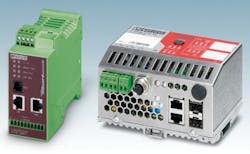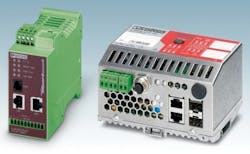Plant Meets Discharge Standards While Lowering Energy Costs
By John E. Olson and Farid Kade
The town of Elkton, MD, located near the head of the Chesapeake Bay, has a population of approximately 16,000. In 2005, the Maryland Department of the Environment imposed new nutrient removal requirements for Elkton's wastewater treatment plant. The town's existing attached growth activated sludge system could not provide the level of nitrification and denitrification required to meet these new effluent requirements. In addition, Elkton's old facility was at its design capacity and would not be able to keep up with the town's growing population.
The town's engineer, Stearns & Wheler (Boone, Md.), decided the best solution was to build a new enhanced nutrient removal (ENR) facility. The new 3.2 mgd facility, which came online in December 2008, uses a Siemens ENR process that features a three-channel Orbal® basin. This process is a suspended growth, activated sludge process designed for high-rate nutrient removal. A Siemens SmartBNR™ process control system is also incorporated into the plant design. This control system provides automatic adjustment of aeration equipment and recycle rates to compensate for the variability of treatment conditions caused by diurnal flow and load changes. The result is very stable, energy-efficient operation.
Activated Sludge System
The Orbal activated sludge system is a series of concentric oxidation ditch channels. The system operates as a "tanks-in-series" system, which provides higher overall kinetic reaction rates. This allows treatment of high organic loadings, thus reducing the size of the basins and lowering construction costs.
Screened and de-gritted wastewater is directed to the outer channel of the basin where it is mixed with return activated sludge (RAS) from the clarifiers to form the system's mixed liquor. The combined mixed liquor passes progressively through the Orbal system's channels before flowing to the final clarifiers.
Each channel contains a volume of treatment capacity that has defined environmental conditions. The outer channel is operated as an aerated-anoxic reactor with dissolved oxygen (DO) levels near 0 mg/L. Simultaneous nitrification/denitrification and phosphorus release occurs in this zone. Oxidation Reduction Potential (ORP) is used to monitor the condition of the outer channel.
The middle channel is a transition zone between the outer anoxic channel and the inner aerobic channel. Its condition may vary depending on the load coming into the plant.
The inner channel is maintained in an aerobic state with positive DO levels. The operators of this system have found that the most efficient nitrogen removal takes place with the inner channel at or slightly above 1.0 mg/L. This supports enough final nitrification required to complete treatment while enhancing total nitrogen removal and supporting energy efficiency.
Each channel is physically separated so the environment within that channel can be controlled by the SmartBNR control system to produce consistent treatment results.
The Elkton Orbal basin was designed with a 16-day Solids Retention Time (SRT) to assure nitrification during cold weather operation. Other design parameters are a MLSS of 4,000 mg/L and an organic loading rate of 16 lbs BOD / day / 1000 ft3.
For enhanced denitrification, an internal recycle wall pump with a maximum capacity of 12.8 mgd was included in the design to recycle nitrates in the nitrified MLSS from the inner channel back to the anoxic outer channel. A secondary denitrification zone followed by a re-aeration zone downstream of the Orbal basin was also included in the design to achieve greater than 95% total nitrogen removal. The secondary denitrification zone was designed to provide carbon by endogenous respiration to drive further denitrification. This feature allows for maximum denitrification without the need for supplemental carbon addition, resulting in greater daily operational cost savings.
Predicting Reactor Behavior
Siemens' PLC-based control system uses an integrated control strategy to measure the ORP and DO conditions within each treatment zone of the process.
The control system optimizes oxygen delivery to processes using aerated-anoxic reactors, maintaining precise reactor conditions to enhance removal of both nitrogen and phosphorus, and providing selection of microorganism species that minimize the chance of bulking and other process problems. The control system predicts reactor behavior and changes conditions in advance of operational problems. It plays a vital role in meeting effluent quality in an energy-efficient manner.
The control system offers precise control of simultaneous nutrient removal in the aerated-anoxic reactor (outer Orbal channel) and provides predictive aerator response, allowing it to control reactor conditions.
It also has the capability of automated SRT control and stormflow operation mode, allowing for hands-free operation. The SRT control feature measures the solids inventory in the process and wastes sludge to maintain a constant target sludge age. Stormflow operation mode automatically controls the solids loading rate on the clarifiers and ensures that solids do not wash out of the plant during a heavy rainstorm event. Elkton's SmartBNR system includes the automated stormflow feature which spares operators from having to be onsite 24/7 to monitor influent flow conditions.
| Table 1: Elkton, MD WWTP Design Parameters | |||
| Design Influent Characteristics | Design Effluent Requirements | ||
| Flow, MGD | 3.20 | ||
| BOD5, mg/L | 280 | BOD5, mg/L | 10 |
| TSS, mg/L | 318 | TSS mg/L | 10 |
| NH3-N, mg/L | 36 | NH3-N, mg/L | 1.0 |
| TKN, mg/L | 46 | ||
| TP, mg/L | 12 | ||
| TN, mg/L | TN, mg/L | 3.8 | |
| Table 2: Summary of Elkton MD WWTP Secondary and Tertiary Treatment Data: April - November 2009 Effluent Quality | ||
| Effluent Characteristics | ||
| Flow, MGD | 1.80 | |
| Power | 1,930 kWh/MG | 0.97 kWh/lb.BOD |
| BOD5, mg/L | 4.06 | |
| TSS mg/L | 3.41 | |
| TP, mg/L | 0.07* | |
| TN, mg/L | 1.95 | |
| *with chemical addition | ||
Winning System
Elkton's ENR WWTP has been producing outstanding effluent quality since it became fully operational in April 2009. The facility is meeting the effluent quality requirements of 3 mg/L for Total Nitrogen and is achieving less than 0.3 mg/L for Total Phosphorus (Table 1). The Maryland Department of the Environment is projecting that the facility will reduce effluent nitrogen by 80% and decrease phosphorus by 70% to the Big Elk River that ultimately empties into the Chesapeake Bay.
However, the ENR system at this facility is designed to biologically reduce nutrient discharges by even more - effluent nitrogen by >90% and effluent phosphorus by >80%. Additional optimization by the plant's operational staff has been able to reduce power consumption by approximately 40% from that used in its old system.
The Maryland Rural Water Association has recognized Elkton's significant improvement in wastewater treatment and recently named the Elkton WWTP as the State's 2010 Wastewater Treatment System of the Year.
The Elkton facility is just one of Maryland's 66 major WWTPs. Upgrading all of them is expected to reduce the amount of nitrogen and phosphorus that flow into the Chesapeake Bay's tributaries by 7.5 million lbs and by 260,000 lbs annually, respectively. WW
About the Authors: John E. Olson, PE, has 32 years of environmental engineering and wastewater operational experience and is currently a technical sales manager for biological products at Siemens Water Technologies. Farid Kade, PE, is a process engineer for BNR processes. Both are located in Waukesha, Wis. Olson may be contacted [email protected]. Kade may be contacted at [email protected].More WaterWorld Current Issue Articles
More WaterWorld Archives Issue Articles

